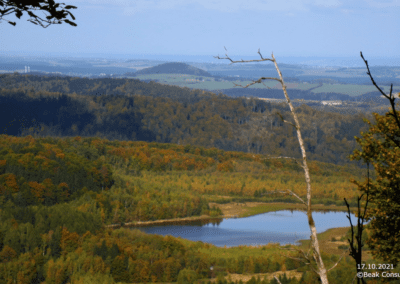IAA Bielatal
History
History of mining activity in Altenberg
The Altenberg deposit is one of the most important tin deposits in Europe. Mining dates back to the 15th century. The mineral mined is cassiterite (SnO2). Thanks to its high density (6.8-7 g/cm3), it can be easily extracted gravitationally from the crushed ore. Fine crushing of the ore was initially carried out manually, later by means of wet punch mills and in modern times with various mills. Initially, slurry trenches were used for enrichment and later various chutes and hearths. From 1934, a wet mechanical flotation process was used, which reduced tin losses during the treatment process. After the political and economic changes in 1989-1990, mining activities in Altenberg had to be discontinued due to a lack of profitability. In the period from 1446 to 1991, 31.6 million tons of ore were extracted. The mining period from 1947 to 1991 was the most significant, with a total raw ore throughput of 20.6 million tons and a production of 38,694 tons of tin in concentrate (Weinhold, 2002). This corresponds to an extracted metal content of approx. 1.9 kg Sn/t ore. The rather high Sn content in the tailings of approx. 0.2 % shows that the recovery was less than 50 %.
Projects and activities at the Bielatal Tailing
- The final tailings disposal of the IAA took place under the management of the former GVV and now LMBV until 2014.
- Project recomine:,,Technologies for the Extraction and Processing of Lithium Mica from Flush Dumps in the Ore Mountains (TEVLiS) using the Example of the Industrial tailings pond (IAA) Bielatal”, 2022 – 2025. Project coordinator: Beak Consultants GmbH.
References (in German)
LMBV Unternehmenskommunikation, (2014): LMBV konkret, 19th year, issue 5, November 2014.
Contact
Beak Consultunts GmbH
Dr. Christian Schardt
+49 3731 781345
christian.schardt@beak.de
Documents for download (German)
IAA Bielatal topographical map
See on the map
IAA Bielatal on Google Maps
Further links (German)
Die Zinnerz-Lagerstätte Altenberg/Osterzgebirge
Flushing dump Bielatal
Objects of investigation
- Separability and recoverability of useful components (Sn carriers, Li carriers, silicate materials) from the reprocessing residues
- Manufacturability of commercial products
- Conceptual investigation on the degradability of the plant with simultaneous recovery of potential useful components
- Storability of the residues and pollutants
- Rough cost-benefit analysis
The results of the investigation will also be useful in the following areas of knowledge:
- Usability of the ingredients of similar mining residues
- More complete utilization of the contents of primary deposits of the metals Sn, Li, Nb, Ta, W
- Reprocessability of arrears of the metals Sn and Li
- Safe custody of pollutants from mining wastes
Pollutants
Resources
Sn
Li
Ta


